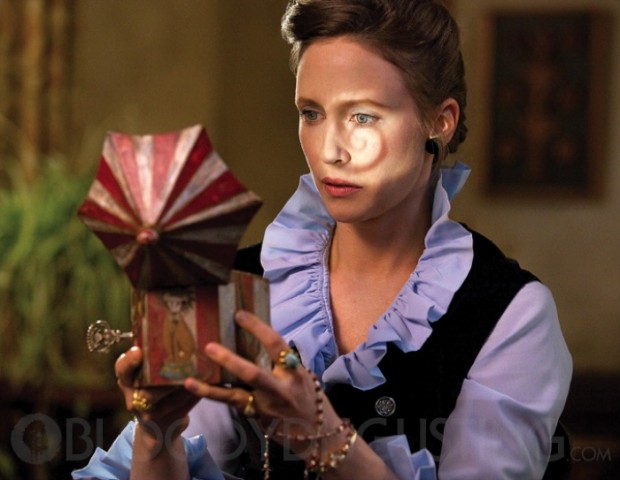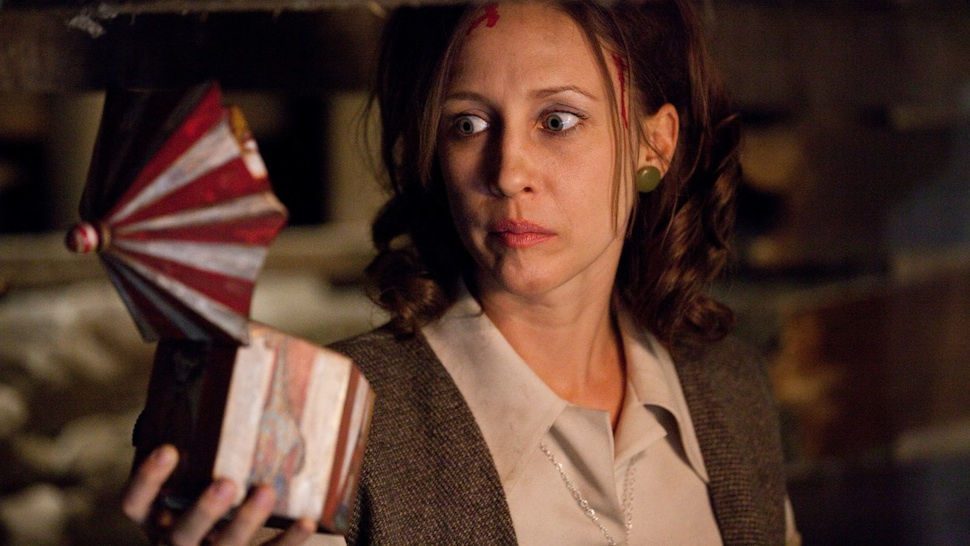|
The
only lesson to
take from The Conjuring is
never to
trust "Amityville Real Estate". This terribly cliché and derivative
haunted house movie is based on a supposedly true story. It's from the
archives
of Ed Warren and his wife Lorraine, two demonologists and paranormal
investigators. If you believe this tosh you'll also believe they have
seen
vampires, werewolves and performed exorcisms. They did establish a
legitimate
organisation in 1952 called "The New England Society for Psychic
Research". For all of its scientific breakthroughs involving vampires,
this work has never prevented them from earning good dollars. After
being
discharged from the Second World War, Ed attended art school and
painted houses
that he said were haunted and then sold them.
One
of their most
famous cases was the Amityville story. In 1974 Ronald DeFeo shot his
six family
members to death as they lay asleep in their beds in a property in
Amityville,
Long Island. The following year, George and Kathy Lutz and their three
children
moved into the same house and claimed it was haunted. Ed and Lorraine
were the
lead paranormal investigators. Despite entire books debunking the
supernatural
aspect of the case, calling it a hoax, the Warrens became consultants
on the
terrible film adaptation four years later. It was followed by ten
follow-up
films, including a remake and a new entry releasing this year. Though
they
would deny it, the Warrens are also religiously motivated. They were
devout
Catholics and on one of their websites, Warren is quoted as saying:
"And I
know that [Biblical beliefs] are facts because I've seen and I've heard
and
I've felt all the things that it talks about." I don't know if they
were
fundamentalists, but that's how they're represented in The Conjuring.

There
is a fascinating
biopic to be made out of the lives of the Warrens but that would be
overreaching for the film's director James Wan. Malaysian born but
Australian-raised, he has failed to match his mega hit Saw, the
start of a sadistic, repugnant series that led
to the rise and fall of the torture porn sub-genre He then
retreated
from the excessive gore and faux-moral ethics to Insidious: a
lousy haunted house movie that wasn't
scary in the slightest. So rarely does The Conjuring divert
from Insidious in story and quality
that it could be regarded as a remake. The film is set in 1971 and
like Amityville Horror
and Insidious it
involves a couple (played by Lili
Taylor and Ron Livingston) and their children moving into a two-story
house by
the lake, and are terrorized by strange noises, smells, creaking doors
and more
violent actions, like people being flung across the room. Patrick
Wilson and
Vera Farmiga feature as Ed and Lorraine, and their investigation
uncovers a
history of witches, demon possession and human sacrifice that
overshadows a
numbingly repetitive main story of thumps, creaks and uncountable
clichés.
One
of the failures of
the script by Chad and Carey Hayes and Wan's direction is that they
have no
sense of "the uncanny". In his essay "The Uncanny", Freud
refers to the German word "unheimlich", which he says is the opposite
of "heimlich" [homely], and therefore the contrary of what is
familiar. Similarly, he argues the uncanny is a result of "intellectual
uncertainty", meaning something uncanny can be one that a person is
unfamiliar
with and has not explored yet. There is nothing unfamiliar or uncanny
in The
Conjuring. By
resembling other fictional horror movies, it diminishes the
authenticity of the
real case. The horror is merely a boring retread of genre
conventions
and it fails to subvert these tired staples.

The
actors are
confined to playing underwritten, stock characters in a two-story
house,
pitched on a grey block of land, with overgrown trees and too many
banging
doors. Wan loves Amityville but
its outright
plagiarism that the architecture of the house is identical. It also
isn't scary
in 2013 to have creaking doors and floorboards, and characters dumb
enough to
follow noises coming from dank basements and closets - it just shows a
depressing lack of ingenuity. Long shots of eerie doorways telegraph
potential
big scares and are followed repeatedly by loud banging noises. If Wan
had any
subtlety as a filmmaker he would know horror is dependent on the
imagination,
not how loud you can make a film.
The
Conjuring shares
an
uncomfortably firm relationship with archaic religious practices too.
There are
obvious iconographic references to films like The Exorcist and The Birds. However,
the film's climax in a
basement involving an exorcism isn't an extension of the horror but in
the eyes
of the film a probable means of healing. The self-belief in this brand
of silly,
fundamentalist exploitation is also compounded through laughable
dialogue such
as: "God brought us here for a reason", and "Religious icons
piss them off". Yet if anyone takes this bunkum seriously they will be
too
young to remember the likes of The Exorcist and Amityville.
Bloodless, tired and overly familiar, The Conjuring was
a story not worth telling again
but that could be the fault of its origins, and not just the derivative
style chosen
by its inexperienced director.
|